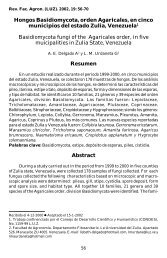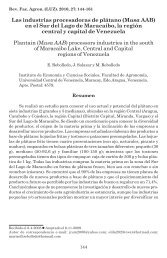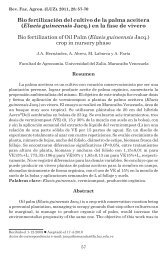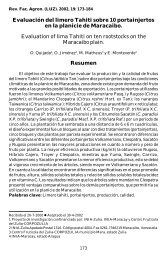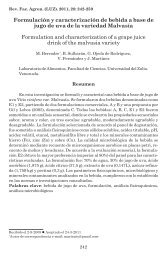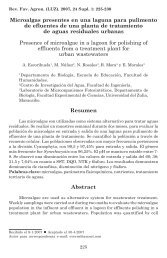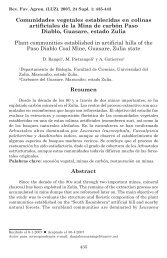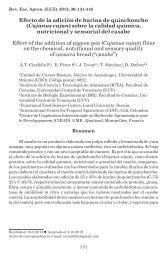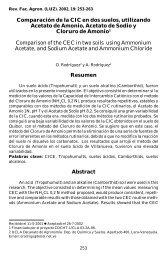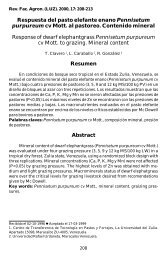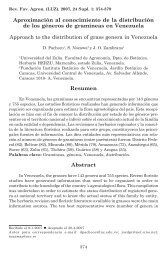Estabilidad del rendimiento de variedades de papa (Solanum ...
Estabilidad del rendimiento de variedades de papa (Solanum ...
Estabilidad del rendimiento de variedades de papa (Solanum ...
You also want an ePaper? Increase the reach of your titles
YUMPU automatically turns print PDFs into web optimized ePapers that Google loves.
Roa et al.<br />
pue<strong>de</strong> interpretarse como adaptación<br />
a ambientes favorables. Según Solano<br />
et al., (1998), el efecto <strong>de</strong> interacción<br />
controla la adaptación específica <strong>de</strong> los<br />
materiales, e indican que se <strong>de</strong>ben seleccionar<br />
los genotipos que presenten<br />
interacciones <strong>de</strong> gran magnitud y <strong>de</strong><br />
signo positivo para un ambiente <strong>de</strong>terminado.<br />
El mo<strong><strong>de</strong>l</strong>o AMMI-2 seleccionó<br />
los genotipos con mayor interacción<br />
positiva (adaptación específica) en los<br />
ambientes respectivos (figura 1).<br />
Otra manera <strong>de</strong> visualizar la<br />
interacción es a través <strong><strong>de</strong>l</strong> biplot generado<br />
con los valores <strong>de</strong> ACP-1 y el<br />
<strong>rendimiento</strong> promedio <strong>de</strong> los<br />
genotipos y ambientes obtenidos <strong><strong>de</strong>l</strong><br />
mo<strong><strong>de</strong>l</strong>o SREG (figura 2). El primer<br />
componente principal (ACP-1) extrajo<br />
un alto porcentaje (76%) <strong>de</strong> la variabilidad<br />
<strong>de</strong> la interacción GA y se<br />
consi<strong>de</strong>ró que este componente fue<br />
representativo para explicar los resultados<br />
y visualizar la adaptación <strong>de</strong> los<br />
genotipos a los distintos ambientes.<br />
De la figura 2 se confirma que los<br />
genotipos más estables tuvieron valores<br />
<strong>de</strong> ACP-1 cercanos a cero, lo cual<br />
concuerda con lo afirmado por<br />
González, (2003) e Ibáñez, (2006).<br />
En cuanto a la selección <strong><strong>de</strong>l</strong> mejor<br />
sitio para evaluar genotipos, el<br />
ambiente A3 fue el más discriminante<br />
como lo indicó la distancia más larga<br />
<strong><strong>de</strong>l</strong> origen al puntaje obtenido (figura<br />
2). Sin embargo, pudo no ser el<br />
más representativo respecto al <strong>rendimiento</strong><br />
promedio y estabilidad <strong>de</strong> los<br />
genotipos en todos los sitios. El ambiente<br />
A5 no fue el más discriminante,<br />
pero las diferencias genotípicas en<br />
A5 pudieron ser más consistentes con<br />
el promedio en los sitios; se observó el<br />
valor ACP-1 cercano a cero.<br />
consi<strong>de</strong>red that this component was<br />
representative to explain results and<br />
to visualize the genotypes<br />
adaptability to different environment.<br />
From figure 2 is confirmed that<br />
genotypes more stable had values of<br />
PCA-1 closed to zero which agree with<br />
those reported by González, (2003)<br />
and Ibáñez, (2006).<br />
In relation to the selection of the<br />
best place to evaluate genotypes, the<br />
environment A3 was the more<br />
discriminant as showed by the longer<br />
distance from origin to the<br />
punctuation obtained (figure 2).<br />
Nevertheless, it could not be the more<br />
representative respect to the mean<br />
yield and genotype stability in all the<br />
sites. The environment A5 was not the<br />
more discriminant, but the genotypic<br />
differences in A5 could be more<br />
consistent with the average in sites;<br />
the value PCA-1 closed to zero was<br />
observed.<br />
In the SREG analysis the bi-lineal<br />
term absorbed the genotypic<br />
variability and interaction GE (G +<br />
IGA). The two first components were<br />
significant and explained on 58.9 and<br />
36.0%, respectively of interaction GE.<br />
The biplot corresponding to SREG<br />
mo<strong><strong>de</strong>l</strong> is shown in figure 2.<br />
This mo<strong><strong>de</strong>l</strong> simplified the study,<br />
differencing two mega-environments:<br />
the best genotype for the first megaenvironment<br />
(A1, A2, A4, A5, A6) was<br />
«Idiafrit» (G1) and the best genotype<br />
for the second environment (A3) was<br />
the clone I-931 (G3). The "Idiafrit"<br />
production was superior to the average<br />
in all the environments. When<br />
the analysis proponed by Yan et al.,<br />
(2000) was applied, the genotypes<br />
located in the opposed extreme of<br />
186



